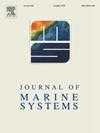Unveiling the mesophotic South Atlantic reef system (SARS): Mapping, evolution, and implications for Marine Spatial Planning (MSP) in the Western South Atlantic
IF 2.5
3区 地球科学
Q2 GEOSCIENCES, MULTIDISCIPLINARY
引用次数: 0
Abstract
Despite the global efforts to recognize the seabed, large-scale mesophotic bioconstructions, the western South Atlantic remains outdated. Utilizing the Geographic Information System (GIS) for reprocessing existing datasets, it was possible to bridge this gap and enable the improvement of Marine Spatial Planning (MSP) in poorly mapped areas. This study presents an unprecedented reanalysis of multidisciplinary public datasets, encompassing information on seabed samples, seabed video inspections, interpretations of the collected data, and dating efforts using GIS and statistical approaches. Results revealed a direct correlation between high carbonate content and gravel, and the visual inspection highlighted the presence of mesophotic reefs, confirming the existence of the mesophotic South Atlantic Reef System (SARS). The most prominent bioengineers were crustose calcareous algae (CCA), rhodoliths (coalescent and free-living form), sponges, corals, and Halimeda. There is a direct relationship between reef age, depth and distance to the coast and an inverse relationship between age and latitude. Countries bordering the SARS should incorporate this unique and fragile seabed feature into their MSP governance, helping strike a balance between conservation and economic growth.
揭示中孔质南大西洋珊瑚礁系统(SARS):南大西洋西部海洋空间规划(MSP)的制图、演变和影响
尽管全球都在努力承认海底,大规模的中鳍生物结构,但南大西洋西部仍然过时。利用地理信息系统(GIS)对现有数据集进行再处理,有可能弥合这一差距,并在地图绘制不佳的地区改善海洋空间规划(MSP)。本研究对多学科公共数据集进行了前所未有的再分析,包括海底样本信息、海底视频检查、收集数据的解释以及使用GIS和统计方法进行的定年工作。结果表明,高碳酸盐含量与砾石直接相关,目视检查突出了中孔质礁的存在,证实了中孔质南大西洋礁系(SARS)的存在。最杰出的生物工程师是硬壳钙质藻类(CCA)、rhodoliths(聚结和自由生活的形式)、海绵、珊瑚和haalimeda。礁龄与深度、到海岸的距离成正比,与纬度成反比。与SARS接壤的国家应将这一独特而脆弱的海底特征纳入其MSP治理,帮助在保护和经济增长之间取得平衡。
本文章由计算机程序翻译,如有差异,请以英文原文为准。
求助全文
约1分钟内获得全文
求助全文
来源期刊

Journal of Marine Systems
地学-地球科学综合
CiteScore
6.20
自引率
3.60%
发文量
81
审稿时长
6 months
期刊介绍:
The Journal of Marine Systems provides a medium for interdisciplinary exchange between physical, chemical and biological oceanographers and marine geologists. The journal welcomes original research papers and review articles. Preference will be given to interdisciplinary approaches to marine systems.
 求助内容:
求助内容: 应助结果提醒方式:
应助结果提醒方式:


